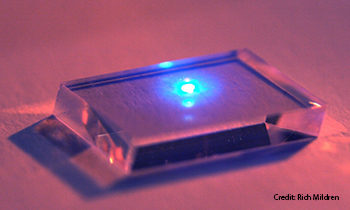
UV laser beam incident on synthetic crystal diamond.
Diamonds are the hardest known substance, but an Australian team has etched various nanopatterns on the surfaces of diamonds with a polarized ultraviolet laser beam (Nature Commun. 5, 3341).
The shape and orientation of the tiny structures, which resemble grooves, ripples or parallelograms, are influenced by the alignment of the beam polarization with the diamond crystal lattice, according to Rich Mildren, a physicist at Macquarie University (Australia) and the corresponding author on the paper.
The Macquarie team used a technique called two-photon surface excitation using polarized light from a pulsed 266-nm-wavelength laser. The researchers took artificial diamond slabs, created via chemical vapor deposition, and focused the polarized beam on the top surface. The chemical bonds within diamonds are strong and directional, and the polarized light breaks them selectively.
For instance, illuminating the (001) crystal face of diamond with light polarized parallel to the (100) surface produces a structure resembling layers of parallelograms. Exposing the same crystal face to light polarized in parallel to the (110) and (210) crystal faces yields parallel ridges. Still other combinations of crystal faces and polarizations result in a texture resembling the ripples sometimes found in wet sand at the beach.
Mildren, whose research group studies the optical properties of diamonds, says he and his colleagues weren't expecting to find this effect. The team had previously found that UV lasers could ablate carbon atoms from diamond, but they did not know how polarization affected the process. The process is intrinsically different from the usual methods of laser ablation; for example, it leaves behind no graphite residue on the diamond surface that was exposed to the beam.
The scientists now want to study the theoretical underpinnings of this nanopatterning effect, which may someday find a use in quantum computing and nanoscale devices that need optical waveguides.
